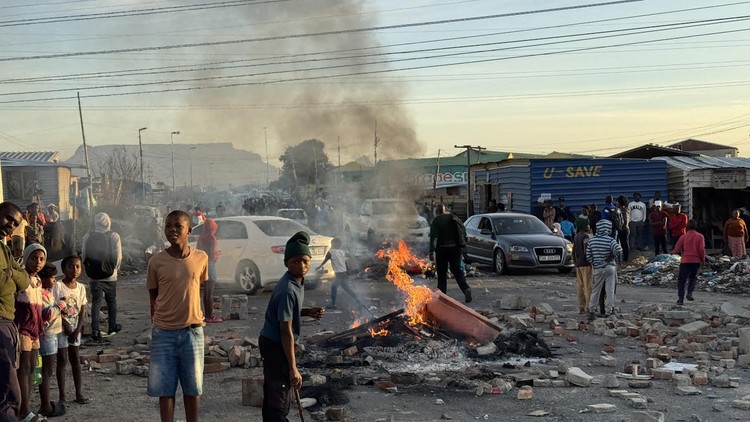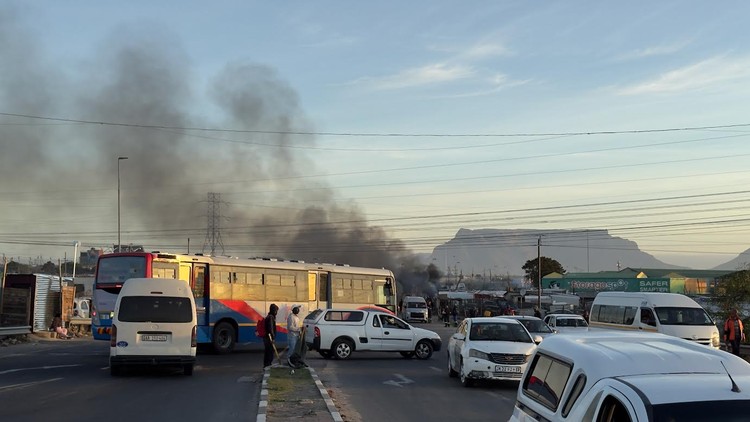Dunoon erupts in protest after the City of Cape Town knocks down walls in informal settlement
Residents have been replacing shacks with brick and mortar homes
Dunoon erupted in protest on Monday after brick walls in an informal settlement were knocked down by the City of Cape Town. Photos: Peter Luhanga
- Protesters blocked Malibongwe Drive and Potsdam Road with burning barricades after the City of Cape Town demolished brick walls in Ezihagwini informal settlement.
- Residents say the walls were part of a house which was occupied. But the City says no one was living there.
- Residents of the settlement who can afford to do so have been replacing zinc shacks with brick and mortar homes.
Trouble flared up for the second day on Tuesday across Potsdam Road and Malibongwe Drive in Cape Town as protesters from Ezihagwini informal settlement vented their fury over the demolition of brick walls in the settlement.
Buses and taxis were prevented from entering the settlement.
On Monday, protesters barricaded roads with rubble and fire, and in the evening, they hurled stones at a goods delivery truck and set it ablaze. The protests were sparked by the demolition of brick “walls” on the edge of Ezihagwini informal settlement on the edge of Dunoon.
Stones were hurled at passing motorists. Children and young men dragged debris from the demolished structure onto the road, setting it alight to block traffic.
By 2pm on Monday, Table View residents were flooding social media with urgent warnings to avoid the area. At peak hour — 5:30pm — not even taxis and MyCiTi buses could get through. Passengers were dropped at the edge of the trouble zone and had to walk home.
Youths fanned the flames as smoke billowed sky-high. When GroundUp tried to take photos, the crowd turned hostile and issued threats.
Community activist and South African National Civic Organisation branch chairperson Sinethemba Matomela said a resident had built a brick-and-cement home on the edge of the road six months ago and was living in it when City of Cape Town Law Enforcement and the Anti-Land Invasion Unit arrived on Monday to demolish the house.
Matomela said as far as he knew, no eviction notices had been issued before the demolition.
“Residents believe it is unfair. The City should have demolished the building while it was under construction, not six months later,” he said. “Residents say an injury to one is an injury to all. They believe it can also happen to them.”
He said shack fires are a persistent threat in Dunoon’s informal settlements. People in areas such as Thembeni, Bhekela, Ekuphuleni, Siyahlala, Site 5, and Zwezwe had replaced fire-prone shacks with more permanent brick structures for safety and durability.
Rat infestations had also worsened living conditions in zinc shacks, with some residents reporting that rats had eaten their groceries and even bitten children in their sleep.
“Residents are building brick houses for safety. The government is reluctant to build houses for people. People are building their own houses.”
He said the City should create clearer and more accessible processes for residents to comply with building by-laws that restrict the use of bricks and cement in informal settlements.
“They talk about compliance, but they’re the ones who understand it … we don’t. They should hold public participation meetings in the township to educate people about what compliance actually means,” he said.
Asked about another protest along Malibongwe Drive in Zwezwe, he said it was connected because residents there had also constructed homes using bricks and cement.
Asked how community leaders planned to quell the unrest, he said the responsibility lay with the City.
“If the City wants the whole of Dunoon to rise in protest, it will happen,” he said.
Buses and taxis were prevented from accessing the area.
City of Cape Town Law Enforcement spokesperson Wayne Dyason said the City was aware of the protest along Malibongwe Drive in Dunoon after officials demolished three brick-and-mortar walls that, he said, had been erected unlawfully.
“Please note, no structures were demolished,” said Dyason. “The ‘walls’ were not occupied and the action was carried out in terms of a final court order.
“The walls were identified by city officials and the owners were served notices to remove the walls, but they failed to comply. This is a land invasion site and any person intending to build should be authorised by the landowner,” he said.
He said the owners of the walls had not submitted building plans in terms of the law for approval to the local authority.
“The residents were consulted and informed about their unlawful conduct and their contravention of the High Court order, hence they were issued with compliance notices,” he said.
Dyason said the City had implemented measures to contain the unrest and would maintain a presence in the area until tensions eased.
Western Cape SAPS spokesperson Warrant Officer Joseph Swartbooi confirmed that a truck had been damaged when protesters pelted it with stones.
He said Public Order Police had been deployed to Malibongwe Drive in response to unrest caused by ‘disgruntled’ community members.
“Their actions came as a result of dissatisfaction with the removal of illegal structures. Reports suggested that a truck was damaged when community members pelted stones at the vehicle. No one sustained any injuries.”
Support independent journalism
Donate using Payfast

Don't miss out on the latest news
We respect your privacy, and promise we won't spam you.
Letters
Dear Editor
This is so disruptive for business in Killarney Gardens, and many are considering leaving the area. Many jobs are provided for the informal residents from Dunoon. But it is not safe at all anymore.
Shutting down roads and damaging Infrastructure is not the way forward. Stoning vehicles is soul-destroying and not on...
The police have not helped at all guiding traffic in and out of Killarney Gardens. Been free-for-all so far.
Time for a re-think.
Dear Editor
Protesting residents in Dunoon are being disingenuous when suggesting that it is the City's responsibility to "educate" (sic) residents of informal settlements about the need for compliance and, wait for it, what compliance actually means! Not only is the proposal absurd but local ANC ward councillors who are in fact the obvious choice in educating residents of this need are allegedly stoking the flames of discontent in order to distract from organised land invasions and other acts of criminality.
The City of Cape Town must be resolute in its application of spatial planning and not allow this to degenerate into the chaos and lunacy it seeks to foster.
Dear Editor
Why is it that the people who flooded into the Western Cape feel so entitled to everything at no expense to themselves? I can't say free of charge as the COCT is using our tax money, i.e. money from the rate payers like myself. So every three years, when the COCT needs more money, both for themselves and these freeloaders, they increase the value of my property well beyond what is reasonably acceptable – it's a thumb-suck valuation based on how much money the COCT wants. This leftist woke attitude is busy ending all over the world – it needs to end here too.
Dear Editor
Who authorized the erection of double story wood and iron shacks in Joe Slovo camp alongside the N2 highway? They stand on wooden stilts. Some are built over the river. Others have balconies.
MEC Popheim and the mayor's office failed to respond to complaints, other than that inspectors found no illegal structures in the area. What an insult to my intelligence to what can be seen from miles around. Continue to ignore. Wait for the explosion when trying to remove it when it reaches epidemic heights.
I wonder how much replacement material will be issued at my cost in event of fires. Nevermind loss of life and injuries in an emergency evacuation. Try building an afdak next to your proper house and see them pounce on you. Ignore and get court orders to demolish. Paid for with our rates' money.
Stop currying favour and creeping for votes. No pay, no play. Without prejudice.
© 2025 GroundUp. This article is licensed under a Creative Commons Attribution-NoDerivatives 4.0 International License.
You may republish this article, so long as you credit the authors and GroundUp, and do not change the text. Please include a link back to the original article.
We put an invisible pixel in the article so that we can count traffic to republishers. All analytics tools are solely on our servers. We do not give our logs to any third party. Logs are deleted after two weeks. We do not use any IP address identifying information except to count regional traffic. We are solely interested in counting hits, not tracking users. If you republish, please do not delete the invisible pixel.


